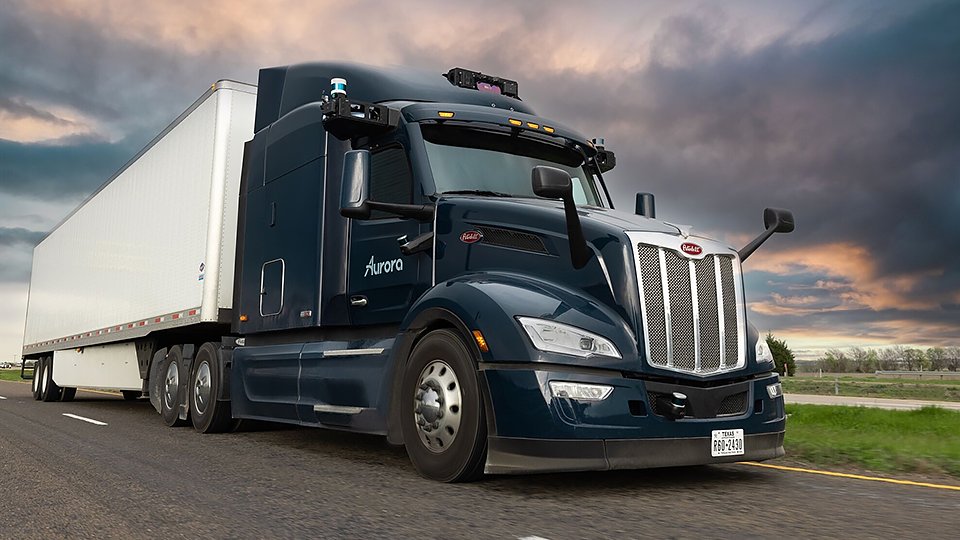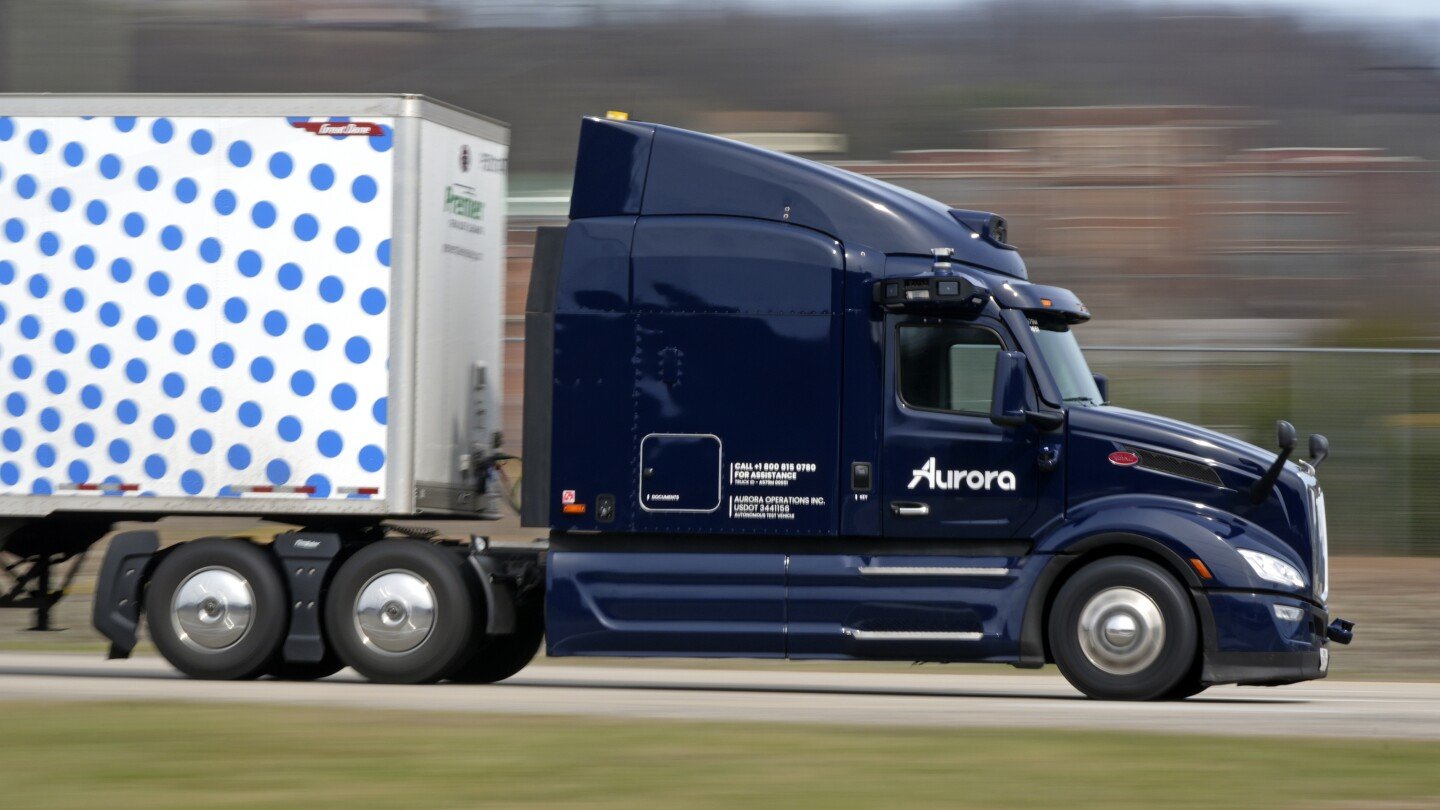- Aurora self-driving trucks, developed by Aurora Innovation, have achieved a major milestone by commencing driverless nighttime operations on the Dallas-to-Houston route, effectively doubling potential freight efficiency.
- While night driving is now validated, overcoming rain remains a key challenge; Aurora aims to enable safe operations in rain by the end of 2025, with the Aurora Driver designed to slow down and proceed cautiously in adverse weather.
- Aurora plans to scale to tens of driverless trucks by the end of 2025 and hundreds by 2026, partnering with companies like Volvo and PACCAR to integrate self-driving technology into commercial fleets.
Aurora self-driving trucks have moved from controlled tests to real commercial corridors — and are now hauling loads through the night. The development doubles utilization potential for the trucking industry, unlocking the economics of driverless freight. Research shows autonomous trucking could increase energy efficiency by up to 32% relative to traditional trucking, and when combined with 24/7 operations, these efficiency gains compound significantly.
For freight companies, this means:
- Reduced per-mile costs through improved asset utilization
- Faster delivery times with round-the-clock operations
- Enhanced reliability with weather-independent operations (once fully implemented)
- Lower emissions through optimized routing and driving patterns
But night visibility and rain are two different problems. In the short term, Aurora can and has shown safe night performance. Rain — especially heavy rain — remains an engineering and operational hurdle that must be managed with layered sensors, conservative behaviors, and clear limits on where and when the truck will drive.
Why Nighttime Driving is a Challenge for Autonomous Systems
“If you can’t drive through the rain, it’s not a very useful product.” – Chris Urmson, (Founder, Aurora Innovation)
Nighttime driving presents several challenges for autonomous systems like autonomous trucks, mainly due to the limitations of sensor technologies and environmental factors. One key challenge is the reduced visibility at night, which impairs the performance of traditional cameras used by autonomous vehicles.
Current automotive image sensors, predominantly CMOS (complementary metal-oxide-semiconductor) sensors, struggle with low light conditions because the input light is insufficient to overcome the sensor’s internal noise. This leads to poorer image quality and less reliable object detection.
Furthermore, short exposure times are required to prevent image blur caused by vehicle motion, which further constrains the sensor’s ability to gather light effectively in dark scenes. This results in autonomous systems having difficulty distinguishing between obstacles and background, complicating the detection algorithms and reducing safety measures like automatic emergency braking during nighttime driving.
Current Fleet Operations and Metrics
Aurora Innovation reported in its second-quarter letter to shareholders that it now has three self-driving trucks operating commercially between Dallas and Houston, and logged more than 20,000 driverless miles by the end of June.
| Metric | Current Status | Future Projections |
| Active Trucks | 3 commercial vehicles | Tens by end 2025, hundreds by end 2026 |
| Miles Driven | 20,000+ driverless miles | Scaling with fleet expansion |
| Operating Routes | Dallas-Houston | Expanding across the Sunbelt |
| Revenue | $1 million Q2 2025 | Growth tied to fleet scaling |
| Operating Hours | Now includes nighttime | 24/7 operations |
The Rain Challenge: Aurora’s Next Frontier
Weather conditions present unique challenges for autonomous vehicles that go far beyond what human drivers experience. While a human driver can intuitively adjust to rain, snow, or fog, autonomous systems must process these conditions through sensors and algorithms that can be dramatically affected by precipitation.
Rain presents a more complex and greater challenge for autonomous vehicles compared to nighttime driving primarily because it interferes with multiple critical sensor systems simultaneously and alters the physical driving environment.
The company explained that its latest version of Aurora Driver will automatically slow the truck and proceed with caution whenever it encounters rain, snow, or fog. This cautious approach demonstrates Aurora’s commitment to safety, but it also highlights the complexity of achieving full weather independence.
The technical challenges are multifaceted:
- Sensor limitations: LiDAR and camera systems can experience reduced effectiveness in heavy rain or snow
- Road surface changes: Wet pavement affects vehicle dynamics and braking distances
- Visibility reduction: Autonomous systems must navigate with the same reduced visibility that challenges human drivers
- Predictive modeling: Weather conditions can change rapidly, requiring sophisticated forecasting and adaptation
Aurora’s Weather Strategy and Timeline
Aurora said that in the second half of 2025, it will start sending its self-driving trucks out at night and during adverse weather conditions like rain or heavy wind. With nighttime operations now achieved ahead of schedule, the focus has intensified on weather capabilities.
The company is taking a methodical approach to technical solutions. Rather than attempting to solve all weather conditions simultaneously, Aurora is likely prioritizing the most common conditions first—particularly rain, which affects the largest percentage of driving time across their operating regions.
Safety Protocols and Monitoring
Aurora’s commercial self-driving trucks have a human “observer” present during operations, providing an additional safety layer while the technology continues to mature. This approach balances innovation with risk management, allowing Aurora to gather real-world data while maintaining safety oversight.

Sensor Suite: The Heart of Aurora’s Self-Driving Technology
At the core of Aurora self-driving trucks is a harmonious blend of sensors that make overcoming night and rain (soon) possible. Here’s a table summarizing the key components:
| Sensor Type | Function | Advantages in Night/Rain |
| FirstLight Lidar | Detects distance and velocity using continuous light beams | Sees 450m+ in dark; better in fog/rain than traditional lidar; detects low-reflectivity objects like pedestrians at night. |
| Imaging Radar | Creates 3D environmental maps | Precise imaging in rain, fog, snow; tracks acceleration over 400m. |
| Cameras | Object detection and classification | Automotive-grade with custom lenses for low-light; fuses with other sensors for robust perception. |
Where Aurora is Today — Milestones and Scale
From its inception, Aurora Innovation has made steady strides in self-driving technology.
- 2017 Founding and Early Partnerships: Aurora was established with a vision for safe autonomous vehicles, quickly partnering with Volvo and PACCAR to integrate the Aurora Driver into Class 8 trucks.
- 2021 Public Listing: The company went public via a SPAC merger, raising $2 billion to fuel development.
- 2024 Driverless Launch: Aurora self-driving trucks began commercial operations without safety drivers on Texas highways, logging over 20,000 driverless miles by mid-2025.
- July 2025 Nighttime Expansion: Validated for night driving, enabling day-and-night autonomy and boosting freight efficiency.
- Terminal Network Growth: Opened a new terminal in Phoenix, expanding routes beyond Texas.
Competitive Landscape and Market Position
Aurora Innovation, Inc., has successfully launched full-fledged freight services using self-driving trucks in the US, making it the first to deploy a self-driving class 8 commercial truck operation on public roads.
This first-mover advantage in commercial operations provides Aurora with invaluable real-world data and operational experience that competitors will need years to replicate. Every mile driven, every successful delivery, and every challenge overcome contributes to a growing database of knowledge that strengthens their autonomous driving algorithms.
Scaling Challenges and Opportunities
Aurora plans to have “tens of driverless trucks” operating on public roads by the end of the year and “hundreds” by the end of 2026. This aggressive scaling timeline reflects both confidence in their technology and the intense competitive pressure in the autonomous vehicle market.
The scaling challenge extends beyond simply manufacturing more vehicles. Each new route requires extensive mapping, testing, and validation. Each new weather condition demands additional algorithm development and safety validation. The complexity grows exponentially with each expansion.
Machine Learning and Weather Adaptation
The Aurora Driver system continuously learns from every weather condition it encounters. Machine learning algorithms analyze patterns in sensor data, vehicle behavior, and environmental conditions to improve performance over time. This means that with each rainy drive, the system becomes more adept at handling similar conditions in the future.

Regional Expansion and Route Development
Over the next year, Aurora Innovation CEO Chris Urmson wants to “unlock” the Sunbelt of the United States, a southern route where its self-driving trucks will expand operations beyond the current Dallas-Houston corridor.
This geographical focus makes strategic sense for several reasons:
- Weather patterns: The Sunbelt experiences more predictable weather with fewer extreme conditions
- Economic activity: Major freight corridors connect key distribution centers
- Regulatory environment: Southern states often have more favorable regulations for autonomous vehicle testing
- Infrastructure: Well-maintained highways with clear lane markings and signage
Phoenix Terminal Operations
Phoenix terminal now supporting autonomous trips along Aurora’s Fort Worth route, expanding the company’s operational footprint beyond Texas. With this expansion, Aurora is locked in on replicating their successful Dallas-Houston model in new markets.
Transparent Safety Approach
Aurora has prioritized transparency in their safety approach, releasing detailed safety reports that outline their methodologies and safety frameworks. “Aurora’s transparent, safety-focused approach to delivering autonomous” freight services has helped build trust with regulators, customers, and the public.
The company’s safety-first mentality extends to their weather preparation strategies. Rather than rushing to deploy in all conditions, they’re taking a measured approach that prioritizes safety validation before commercial deployment.
Job Market Implications
The expansion of autonomous trucking naturally raises questions about employment impact. However, the U.S. Department of Transportation’s 2021 report on the macroeconomic impacts of automation in long-haul trucking estimated that autonomous trucking is set to create 26,000 to 35,000 new jobs per year on average.
These new roles span various sectors:
- Vehicle monitoring and remote operation oversight
- Maintenance and technical support for autonomous systems
- Fleet management and logistics coordination
- Data analysis and system optimization
Future Outlook
While rain represents the immediate challenge, Aurora’s long-term vision extends to handling all weather conditions that human drivers routinely navigate. Snow, ice, fog, and high winds each present unique challenges that will require specific technological solutions.
The company’s methodical approach—mastering night driving before tackling rain, then moving to more complex weather conditions—suggests a sustainable path toward full weather independence.
Conclusion
Aurora Innovation’s success with nighttime autonomous trucking operations is proof that autonomous freight is transitioning from experimental to operational reality. The company’s measured approach to challenges, prioritizing safety while pushing technological boundaries, has positioned them as the clear leader in commercial autonomous trucking.
The rain challenge ahead is not insurmountable. Aurora’s track record of problem-solving, combined with their real-world operational experience, suggests they’re well-positioned to overcome this next hurdle. When they do, the implications will extend far beyond their company—transforming an entire industry and reshaping how goods move across America.
Also Read:
Top 5 Autonomous Trucking Companies in the US (2025)
6 Best Self-Driving Cars in the US (2025)
Top 20 US Autonomous Vehicle Companies (2025)

I’m Dr. Brandial Bright, also known as the AVangelist. As a dedicated and passionate researcher in autonomous and electric vehicles (AVs and EVs), my mission is to educate and raise awareness within the automotive industry. As the Founder and Managing Partner of Fifth Level Consulting, I promote the adoption and innovation of advanced vehicle technologies through speaking engagements, consulting, and research as we progress to level 5 fully autonomous vehicles.







